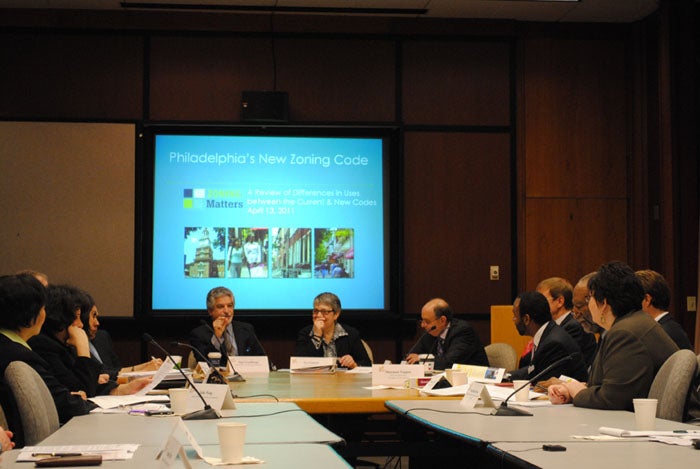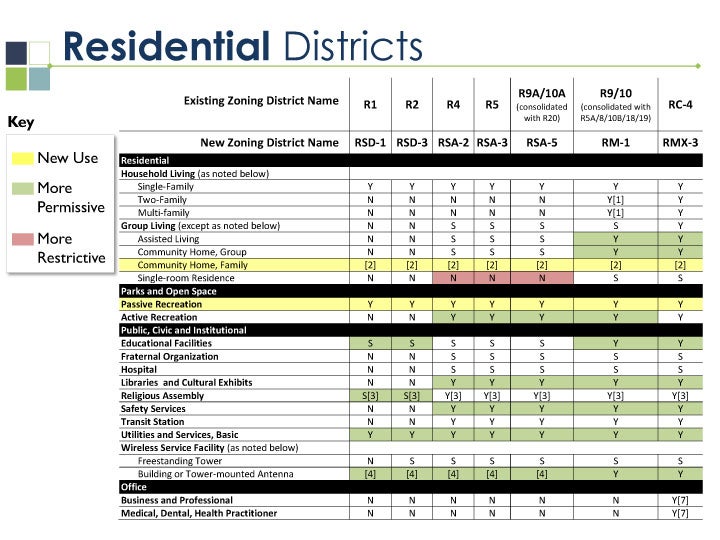Placid discussion of use regulations at ZCC
Less restrictive use regulations in Philadelphia?
So said the Zoning Code Commission at its meeting on Wednesday, which detailed both conceptual and specific changes to uses in the new draft of the city’s zoning code.
Guided by a 43-page document, “A Review of Use Changes in the Zoning Code,” distributed both at the meeting and online at zoningmatters.org, the ZCC’s lead consultant Don Elliott said that the new code’s use regulations are generally more permissive.
A few uses, though, have become more restricted. Single-room occupancy residences have been booted from three of the residential districts, and restrictions on group day care and day care centers have been tightened in four more. The same information, according to Gladstein, was the basis of packets prepared for each City Council member, detailing the specific changes most likely to affect councilmanic districts.
“We’ve reached out to all members and have met with six or seven, and communicated with everybody else,” Gladstein said.
The two council members in attendance, 10th District Councilman Brian J. O’Neill and Councilman-at-large Bill Green who both also serve as commissioners, questioned how the code treated multifamily housing density and the merging of certain commercial districts. O’Neill asked why two-family housing units were folded into the broader multi-family category. Gladstein and Elliott explained that the number of units was now tied to lot size.
“If its a large lot that would accommodate four to six units under the old code, you still could’ve had three duplexes,” Elliott said. “In general, the code isn’t set up so that you can do more units if you do smaller units.”
Following on O’Neill’s question, Green asked about larger houses on larger lots in Northwest Philadelphia neighborhoods.
“There are currently big twins on large lot sizes that may have a few apartments right now. But they could accommodate ten small apartments. You can’t subdivide practically and build, but you could put many more units in,” Green asked. “Is there a way to zone them into something other than multifamily?”
The commission has weighed critically whether or not there should be a category that is specifically related to two-family households, said Deputy Mayor Alan Greenberger, who chaired the meeting. The group will continue exploring the issue with Elliot.
O’Neill and Green also expressed concern for commercial districts changes under the new code.
Merging current commercial districts C-7, ASC (area shopping center), and NSC (neighborhood shopping center) into the new automobile-oriented commercial district CA-1, introduces a number of new uses. “That does create a problem, because you will let a tire store in a neighborhood,” Green said.
“It does allow [the tire store] in a little shopping center, but not at the corner store,” Greenberger clarified.
Green said that by giving a zoning district more permissive uses, the city could run into legal problems if it then tried to restrict those uses, because landowners’ property rights would be harmed.
“You don’t get a do-over, because if you’ve given somebody that right and they’ve exercised it, you can’t take it back in remapping. It’s a taking,” Green said.
Elliott also focused on ongoing revisions to the code during the presentation.
“We expect a trickle of ideas and modifications that may come up,” Greenberger said. “We will continue to make small adjustments until the time it’s approved, and for the next year after that.”
Many of the changes were minor clarifications, but a few could have more substantial impact, including:
- Revised waiting period for Zoning Board of Adjustment and Civic Design Review hearings. Previously, a 45-day period was imposed; the draft has been revised to allow for a meeting to be held more quickly, if applicants and Registered Community Organizations document their meeting more quickly as well.
- The 25-percent limit on dimensional variances was revised to be the “minimum variance necessary.”
- Where use variances have been granted, if an owner or lessee wants to expand, they no longer get an automatic 25% expansion. Instead, they have to meet use variance criteria, which means a trip to ZBA.
- Nonconforming uses either predate the code or predate a change to the code that prohibited them from certain districts. Unlike use variances, which are now further restricted, nonconforming uses may still expand—but only by 15 percent instead of the 25 percent previously proposed.
In the question and answer period that followed, ZCC commissioner Greg Pastore raised the issue of spacing out particular uses, including uses permitted only by special exception, a topic that came up at the most recent Stakeholder X-Change meeting.
“Our general stepping back except in regulated uses, which for whatever reason have been deemed to have a higher impact, seems right. But certain groups in the city will rebel against that because they’ll see a proliferation of certain uses they don’t like that are otherwise perfectly OK. It’s a struggle,” Greenberger said.
“Does anybody here think we need spacing standards for special exceptions?” Pastore asked his fellow commissioners.
“I think that’s one we should bring back to [the] work plan [committee] soon,” replied Peter Kelsen, that committee’s chair.
Gladstein said that work plan should email its rationale for discussions and changes out to the entire commission between this meeting and the scheduled May 11 vote; she said ZCC would not issue a “purple- or magenta-line draft.”
Also at Wednesday’s meeting, Greenberger introduced Sherman Toppin, a new Zoning Code commissioner appointed by the African American Chamber of Commerce. Greenberger reminded the commission that the draft of the new citywide plan has been released, and the public comment period is extended until the end of this month.
The vote on the preliminary report of the ZCC is scheduled for the next full meeting of the commission, to be held May 11. According to Greenberger, on or about May 1, the entire preliminary draft, including changes, will be available on zoningmatters.org.
“There’s an accelerated and intense schedule of meetings that are happening,” Greenberger said.
“Do you all know the math principle of asymptotic approach? It correlates amount of work effort with amount of result, and it’s a curve that basically says that as you get closer to the end, the work effort increases exponentially to move the result just a little tiny bit further.
“And that’s the phase we’re in.”
Upcoming ZCC meetings:
- Stakeholder X-Change meeting: Dimensional Standards. Tuesday, April 19, 8:00 a.m. 1515 Arch Street, 18th Floor.
- Stakeholder X-Change meeting: Other Development Standards. Wednesday, April 27, 5:00 p.m. 1515 Arch Street, 18th Floor.
- Stakeholder X-Change meeting: Parking and Signs. Tuesday, May 3, 8:00 a.m. 1515 Arch Street, 18th Floor.
- May ZCC meeting, and scheduled vote on the preliminary report to City Council. Wednesday, May 11, 8:00 a.m. 1515 Arch Street, 18th Floor.
WHYY is your source for fact-based, in-depth journalism and information. As a nonprofit organization, we rely on financial support from readers like you. Please give today.














